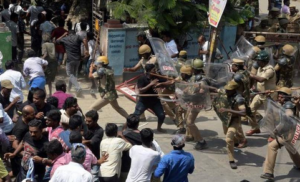
12th June 2018. These in depth articles by Ilangovan Rajasekaran were carried as a cover story in Frontline magazine, 22nd June print edition.
The first covers the myriad police violations of 22nd May in Thoothukudi, including attempts to split the movement prior to the protest, and torture of youth after the fatal shootings. The second details the plight of Thoothukudi’s fishermen whose seas have been rendered barren due to pollution.
Gunning down a protest
The police open fire, in a “stage-managed” riot situation, on people protesting against the Sterlite copper smelter plant in Thoothukudi, Tamil Nadu. The death of 13 people and the grievous injuries suffered by many have only strengthened the residents’ resolve to fight against industries that threaten lives and livelihoods.
On the morning of May 22, Vanitha stood at the doorstep of her one-room house in Lion’s Town, a fishermen’s locality in Thoothukudi town in southern Tamil Nadu, and caught sight of her daughter waving to her from the street corner. The 18-year-old “darling” of her parents and two elder brothers was on her way to the Our Lady of Snows Basilica nearby. Residents had been asked to assemble there to participate in a rally to mark the 100th day of the “anti-Sterlite struggle”.
Snowlyn Jackson’s enthusiastic involvement in social issues did not surprise Vanitha. Snowlyn had cleared her school final board examinations a week ago and was preparing to apply for a degree course in law. She, Vanitha said, had been passionate about issues concerning the livelihood of fisherfolk. Naturally, Snowlyn responded spontaneously to the call for a “Seize the Thoothukudi district collectorate” rally in order to get a promise from the Collector to close down Sterlite Industries’ copper smelter plant in the town. “She took her sister-in-law and her eight-month-old baby, too, for the agitation,” Vanitha told Frontline.
The protest left 13 people dead in the worst police firing Tamil Nadu has witnessed since Independence. Snowlyn fell to a police bullet near the collectorate. The impact of the gunshot was such that it ripped off a part of her face. “Every day I used to give her a kiss. Now I cannot even kiss her goodbye. Where is her angelic face?” Vanitha broke down even as her husband wept uncontrollably beside her.
A crowd of around 500 people, mainly women and children, had gathered in front of the historical church at about 9 in the morning. Placards and handwritten posters demanding the closure of the plant were distributed to them. In the surrounding villages, too, people had started to set out for the collectorate. One of the villages, A. Kumareddiyapuram, was where a defunct Anti-Sterlite Movement of the 1990s found new vigour that sustained it for 100 days.
The Sterlite plant, people allege, has been a polluter of air and water ever since it was set up more than 20 years ago. Sterlite Industries, a subsidiary of the London Stock Exchange-listed conglomerate Vedanta Resources, has been synonymous with controversy since the day its foundation was laid in 1994 by Chief Minister Jayalalithaa despite stiff opposition (see “Pressure in London” on page 21). In the past two decades it was closed down several times for flouting various rules and also because of accidents, some of them serious (“Saga of a struggle”, Frontline, April 27, 2018). A gas leak in the early hours of March 23-24, 2013, left half of Thoothukudi’s nearly four lakh residents gasping for breath even as they slept. Sterlite denied the leak, the source of which still remains a mystery. Since then people of the town have dreaded the plant.
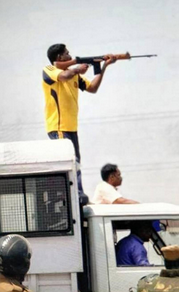
Cutting across caste and communal lines, people from all walks of life joined hands against the industry. This ruffled a few vested interests that were apprehensive of such unity upsetting their well-laid-out plans. Jothikumar, a college student belonging to the Nadar caste, and his friends reached the church to join the protesters. “When the gas leak occurred in 2013, my father, an asthma patient, almost choked to death. We had to rush him to hospital to save his life,” Jothikumar said. He recalled his father telling him that “these elements had employed the ‘divide and rule’ ploy to neutralise all anti-Sterlite movements since 1996”. The anti-Sterlite agitation has to be evaluated in two phases—1994 to 1999 and from March 23, 2013, when the gas leak hit the town, and the present movement which went on for 100 days.
The two major social groups of the town, Nadars, who are predominantly traders, and fishermen, have been cautious against any move to divide them on communal lines; the experience of 1996 when riots broke out and a couple of fishermen died is something that is not forgotten easily. “We are clear in our stand. We do not wish to be a participant in any devious act that would divide the town on communal lines. We fight as one. That is why the traders’ body extended total support to any peaceful anti-Sterlite agitation,” said a traders’ representative.
“Festive mood”
As people started marching through the streets, the crowd swelled into a massive rally that peacefully made its way towards the collectorate. Social media updates and mobiles made coordination easy for groups of protesters converging at the collectorate from different locations. “In fact, it was a festive mood. We were asked to come with our families. The Federation of Anti-Sterlite Movements, an umbrella organisation of socially conscious groups, which has coordinated the struggle against the plant, asked us to bring drinking water, food, eatables, etc., to prevent dehydration and fatigue,” said Palpandi, 45, who was recuperating at the Thoothukudi Government Medical College Hospital from an injury he suffered.
He said that the organisers had told the people that it was a token protest and that they could disperse after meeting the Collector. “Is it not absurd to accuse us, who came with our wives, daughters, sons and children, of indulging in violence? It was the police who taunted the peaceful protesters by hurling abuses all along the route of the rally,” he said.
A few Tamil television channels had telecast the rally live in the morning but, for reasons best known to them, discontinued it midway.
If the claims of the people are true, the vital questions would be when and why the situation deteriorated into a serious law and order problem as claimed by the State government and its police. The key to answering these questions can perhaps be found in a series of developments that took place in quick succession.
The administration had clamped Section 144 of the Code of Criminal Procedure (unlawful assembly) on the town on May 21, but its enforcement was inconsistent; initially it was imposed in the Tuticorin South police station area, which includes major parts of the town, and the SIPCOT police station area, where the Sterlite Industries and the collectorate lie.
On May 22, a contingent of policemen first engaged the rallyists near the Tuticorin South police station and asked them to disperse. Even as people who had assembled in the town were asked to disperse, those in the villages were allowed to proceed. This, a senior advocate pointed out, caused confusion and mistrust in the minds of the people. “They thought the police were trying to break their solidarity,” he said.
Soon arguments broke out between the public and the police at various points en route the collectorate. “We tried to make them understand that it would only be a token protest at the collectorate and that we had no idea of indulging in any unwarranted activities. We wanted a promise from the Collector on the status of the plant in order to convince our people,” said Bryton, 26, a labourer, who was injured in the police firing.
Collector’s absence
District Collector N. Venkatesh, however, was nowhere to be found at the headquarters. A senior revenue official told Frontline that the Collector was in Kovilpatti town to conduct “jamabandhi” (revenue auditing) and had remained at the panchayat union office at Ottapidaram, some 25 kilometres from Thoothukudi, when the police action was under way. This was at a time when the agitation was peaking and the tension was palpable. “Section 144 was in force and the Anti-Sterlite Movement had declared well in advance that it would be laying siege to the collectorate on that day,” said Henry Tiphagne of People’s Watch, a Madurai-based human rights organisation.
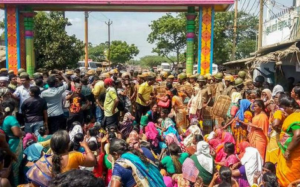
But for reasons best known to him, Venkatesh was not present at the headquarters, leaving the district administration in the hands of the police for two full days. The police force was led by the Additional Director General of Police (Law and Order) and had four Inspectors General (I.Gs), two Deputy Inspectors General (DIGs), 15 Superintendents of Police (S.Ps) and scores of Additional Superintendents of Police (ASPs) and Deputy Superintendents of Police (DSPs) when violence rocked the town. A semblance of order returned only after the government sent Tirunelveli Collector Sandeep Nanduri to take charge from Venkatesh on May 23. P. Mahendran, Thoothukudi S.P., was transferred the same day. But the State government had no explanation to offer on the absence of senior revenue officials, including the Collector, the District Revenue Officer and the Sub Collector, during the crisis.
The State government ordered the suspension of Internet services from May 23 to May 28, an act that has no precedent in Tamil Nadu, to stop the spread of “provocative messages with half-truth”. The order was withdrawn on May 27.
Intelligence failure
The run-up to the violence pointed to the hard reality that the intelligence machinery had failed the district administration. “The police promised us that nothing would happen. We believed them,” the revenue official said. It perhaps offered a plausible answer to the Collector’s interest in routine work. A clarification from the State government on the absence of senior officials would help explain why a couple of junior-level officers in the rank of Deputy Tahsildhar had issued the firing orders. Under Section 21 of the CrPC, they are special executive magistrates and have “all the powers exercisable by an executive magistrate”.
The public outcry over the heavy loss of human lives left the All India Anna Dravida Munnetra Kazhagam (AIADMK)-led State government red-faced, and it moved quickly to close down the plant on May 28 by an order from its Forests and Environment Department citing non-compliance with rules. (See “Arbitrary act” on page 19.)
On May 28, the department pointed out that the Tamil Nadu Pollution Control Board (TNPCB) had issued directions on May 23 for the closure of and disconnection of power supply to the unit. Accordingly, the government directed the TNPCB to seal the unit and close the plant permanently under Section 18(1)(b) of the Water Act, 1974.
On May 29, the Managing Director of the SIPCOT Industrial Complex cancelled the allotment of land (342.22 acres) for the proposed expansion of the plant (Phase II) in view of the series of agitations and protests and the concerns of the people of the area about their health. It further noted that the land price collected would be refunded as per the norms of SIPCOT. “It is an unfortunate development. We will decide the future course of action soon,” said a statement from Vedanta.
Chief Minister Edappadi K. Palaniswami told the Assembly on May 29, while replying to a special calling attention motion on the issue, that “under unavoidable circumstances the police were forced to take action”. He, however, did not mention even once that 13 people had died in police firing. Instead, he said that the 13 had died, without responding to treatment in hospital. He did not fail to blame the opposition Dravida Munnetra Kazhagam (DMK) and anti-social elements for the violence.
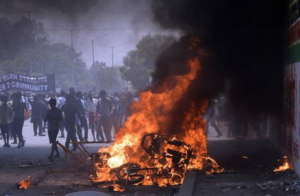
The mishandling of the situation began even before the announcement of the 100th-day rally. Instead of engaging the campaigners in dialogue, both the district administration and the police, activists claimed, attempted to split them, which led to suspicion and mistrust among the people. A peace meeting was organised the previous week to which only a few activists and traders were invited even as major groups that were involved actively in organising the agitation were kept out. “It was a deliberate move to split the anti-Sterlite organisers, which boomeranged. Those who attended the meeting were coerced into accepting the suggestions to stage a token dharna on a private school campus. The majority vetoed it and decided to go ahead with the rally,” said Tiphagne.
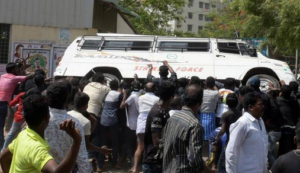
The first signs of trouble came when the police began stopping at various places rallyists making their way to the collectorate. At first, the conflict between the police and the people was limited to sporadic incidents of heated arguments and the occasional flinging of footwear. But when the police resorted to lathi charge at some points, the crowd responded with stones. “It was the police that drew the crowds to the collectorate campus. Had they wished to break up the rally, they could have done it easily, either at VVD Signal junction or at Madathur, in the 9-km stretch,” pointed out Vanchinathan, a legal adviser to the anti-Sterlite protest committee and a member of the Makkal Urimai Padukappu Maiyam against whom five cases have been registered under various sections.
Informed sources said the disturbances first started when the police led by Thoothukudi ASP Selvanagarathinam resorted to a lathi charge at VVD Signal junction around 11 a.m. The same officer, informed sources said, later in the afternoon led a posse of policemen who opened fire near Thereshpuram, 3 km from VVD Signal junction, in which one woman resident identified as J. Jhansi Rani, 37, was killed. That a mob assembled in front of the camp office of the S.P. was said to be the reason for the firing.
Meanwhile, around the same time, at the Tirunelveli bypass road, the police used tear gas against the rallyists and resorted to a lathi charge to disperse the crowd that was moving towards the collectorate. Even women and children were not spared, and many of them suffered injuries. Infuriated by this, a section of the protesters turned aggressive and started throwing stones. “Thus a perfect setting was created to open fire near the collectorate,” said a lawyer-cum-activist.
“Suddenly we heard gunshots”
Crowds of marchers from the town and from the villages defied blockades and arrived near the collectorate around noon. “We were stopped some 300 metres from its entrance. Then we heard a series of gunshots. This was followed by the bursting of tear gas shells and then a lathi charge. There was no warning. We could see black smoke billowing from near the collectorate and the adjacent residential complex of Sterlite. A few vehicles were burning though none of us, the protesters, could go near them. Suddenly we saw people falling to the ground, bleeding profusely. The dead and the dying and the seriously injured were taken away in two-wheelers. Complete chaos prevailed for about 40 minutes when innocents became the hunted,” said Evelyn Victory, 43, who sustained a bullet injury. Soon the enormity of the tragedy near the collectorate started unfolding. The shooting had left nine persons dead. Among them, Snowlyn and P. Tamilarasan, 47, an active anti-Sterlite protest organiser and a member of the Radical Youth Front, died on the spot. Scores of people suffered gunshot injuries and broken limbs. An unconfirmed report claimed that 11 people, besides the dead, had received bullet injuries. Ambulances of the Tamil Nadu Muslim Munnetra Kazhagam and a private hospital were pressed into service to transport the injured to hospitals.
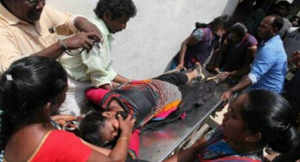
S. Kaliappan, 25, was killed the next day in police firing at Anna Nagar when the relatives of the dead resisted attempts to conduct post-mortem on the bodies. Yet another person, N. Jayaraman, 42, of Usilampatti in Madurai district succumbed to gunshot wounds, thus taking the toll in the police firing to 12. The 13th victim was P. Selvasekar, 42, of Iruvappuram, who died in hospital after he was allegedly stomped by policemen on the chest. This was the worst-ever police firing in Tamil Nadu after the incident at Paramakudi in 2011, in which six Dalits were shot dead, and the one at Kurichankulam in Tirunelveli district in 1980, in which eight farmers were killed.
A list of the dead was included in a written submission made on behalf of the DGP on the firing before the Madras High Court on May 31.
A close study of some of the visuals and the claims of relatives of the dead showed a disturbing pattern in the police firing. It was mostly from close range from powerful weapons.
Vanitha said Snowlyn had been shot in the mouth. The bullet went through her skull before mutilating her face beyond recognition. “They killed my daughter brutally. At least they should have shot her in the legs and torso so that we could see her face,” she said.
Relatives and friends of the victims claimed that “they were shot like sparrows”. Jhansi Rani, who died in Thereshpuram, had a shattered skull. B. Ranjithkumar, 25, of Pushpa Nagar, a promising boxer, and Tamilarasan reportedly had bullets in their heads. J. Antony Selvaraj, 47, of Annai Velankanni Nagar was shot in the chest, while G. Kandaiah, 55, of Ceylon Colony and S. Manirai, 22, were shot in the neck.
Of the 13 killed, four were Dalits and three belonged to the fishermen community. The other victims belonged to the Other Backward Classes.
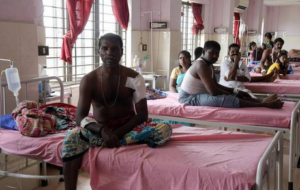
Sandeep Nanduri confirmed the death of 12 persons, including two women, in the police firing and one from injuries in two days. A total of 19 people, he said in a press release, had sustained serious injuries. However, he was silent on the total number of persons with gunshot injuries. As many as 83 people suffered minor injuries. On the side of the police, it was reported that 34 personnel, including 24 men and 10 women, sustained injuries and were admitted to the Tirunelveli hospital. Some 100 vehicles, including four-wheelers and two-wheelers, both government and private, were gutted in the arson. The total loss was estimated at Rs.1.65 crore. The solatium for the families of the dead was enhanced from Rs.10 lakh to Rs.20 lakh pending the post-mortem examination, while a sum of Rs.1.04 crore was paid to the injured as compensation.
Trigger-happy policemen
A critical evaluation of the two-day violence would not only expose the inept handling of the situation by the police but also vindicate the claims of activists and protesters that the police seemed to have “stage-managed” a riot-like situation to execute their sinister objective of instigating the crowd instead of dispersing it peacefully. “Many told us that policemen in plainclothes carrying pistols mingled with the crowd. We did not know from where the bullets came. Many of them could be seen in white shirts and even in dhoti,” said an activist-organiser who escaped death by a whisker.
These claims cannot be dismissed entirely. A video grab showing three men, all in T-shirts and sports trousers, taking aim with long-range rifles from atop a white police van near the collectorate went viral on social media, leaving civil society in shock.
“It is dangerous to employ policemen in plainclothes to mingle with people in such situations. We have a strong suspicion that they were snipers to ‘pick and shoot’ the front-liners of the protest. We accuse the police of resorting to ‘targeted shooting’,” said Tiphagne.
The People’s Union of Civil Liberties (PUCL), in its press release, echoed similar views. It said that “the police resorted to severe and unprovoked lathi charge on the unarmed gathering without giving any prior warning. This is said to have provoked reaction from some sections of the gathering, resulting in stone throwing,” said its national general secretary V. Suresh. The PUCL said that it was a “target killing of unarmed, peacefully agitating protesters” and called it “unconscionable and unconstitutional firing aimed to kill protesters”. But the police justified the firing by claiming that an organised mob, guided by “alien anti-social elements”, attempted to enter the Collector’s office with the intention of ransacking it. “We had information that even some senior officials would have been targeted,” said a police officer. Chief Minister Palaniswami also said that “anti-social elements from outside” had infiltrated and created a law and order situation.
But contrary to their claims, and even as per the video clips said to have been released by the district administration to the media, none of the protesters who indulged in stone-throwing had ever physically entered the Collector’s office.
Informed sources said the police, faced with a rain of stones, withdrew into the Collector’s office and locked the main entrance from inside until another police contingent arrived and chased the mob away. Some unidentified persons could be seen damaging and setting fire to vehicles parked in the locality. In fact, except for the broken windowpanes at the entrance of the collectorate, no other damage, either to the furniture or to the files or documents, could be noticed, the sources said. Even the information kiosk at the entrance remained intact, they added.
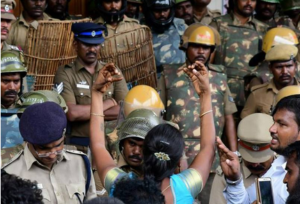
“It was a clear ploy to shift the blame on the outfits that have been shouldering the responsibility of organising the people’s protest against the industry,” said A. Marx of the National Confederation of Human Rights Organisations. He and other activists, who carried out a fact-finding mission, condemned the attempts of the State government and a few right-wing outfits “to demonise the democratic forces” that took up people’s issues. “The shrill cry that anti-social elements had infiltrated the struggle was a feeble excuse to camouflage the gross violation of human rights by the police. None of the organisations involved in the stir is a banned outfit,” pointed out Marx.
Tamilarasan was an active organiser in the anti-Sterlite movement, while N. Jayaraman, who died in hospital of bullet injuries, was a member of the social outfit Makkal Athigaram (People’s Power) in a village near Usilampatti. “After the violence in Thoothukudi, the police have been detaining our members for no reason. We are a democratically functioning unit. We stand with the people who fight for their rights. It is disturbing to portray us as a group of radicals,” said C. Raju, State coordinator of Makkal Athigaram, whose members, he alleged, were being targeted across the State.
“Missing” youth
It was a collective exercise of civil society in Thoothukudi, comprising local people, activists, lawyers, traders, and so on, that saved the situation from deteriorating further. With no responsible senior revenue official available on the ground, Thoothukudi citizens found it difficult to represent their grievances when the police knocked on the doors of their houses in the dead of night for “ferreting out potential troublemakers”, as a senior police officer put it, and whisked away people. “Immediately after the violence on May 22, the manhunt began across the town. We could not talk to an aggressive police which exercised a brutal control over the town. Hence we approached lawyers, who sought an immediate intervention from the judiciary,” said a retired academic and a social worker. The Madras High Court, too, declared that advocates “are entitled to extend legal assistance to the affected parties in accordance with law”.
This positive judicial intervention instilled confidence in the people. A team of advocates of the Tuticorin Bar Association, led by senior advocate A.W.D. Tilak, bailed out innocent youths who were detained in unknown places and subjected to third-degree torture. None of these youths, all in the age group of 16 to 28, was handed over to the judiciary for two full days until the court intervened following a petition. The team of advocates approached Chief Judicial Magistrate (CJM) Bhagavathy Ammal with a petition on May 23 seeking directions on illegal detentions.
The CJM, seized of the seriousness of the matter, appointed Vilathikulam court magistrate Kalimuthuvel as a search officer to verify the claims by visiting the police stations where the detenus were reportedly kept. Before he could go there, the police shifted them, 95 in all, to the police firing range at Vallanadu village. The judicial officer raised objections to the illegal detention in a place that was out of the legal confines and got 30 of them released immediately. They were then brought to police stations, and after registering cases under Sections 147, 148 and 353 of the Indian Penal Code and Sections 3 and 4 of the Tamil Nadu Public Property (Prevention of Damage and Loss) Act, 1992, produced in courts in batches on May 24. However, lawyers filed bail petitions for all of them before Magistrate Saruhasini, who held an inquiry on each and every petition until late in the night before granting all of them bail.
The lawyers then drew the attention of the judicial officers to the fact that the police had not allowed the youths to undergo medical examination and alleged that this was because they had been subjected to physical torture; they cited as proof the gaping wounds on their bodies. The lawyers alleged that when the youths were taken for medial examination the doctors on duty had refused to record their injuries. The judicial officers visited police stations and the Tuticorin Government Medical College Hospital to record the statements of the injured and ensured treatment for them.
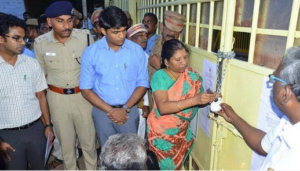
“How could one take a detenu to an extrajudicial place? It was a brazen act of high-handedness of the police. But for the subordinate judiciary, many would have languished in prison,” said E. Athisayakumar, a member of the team. Thus, the lawyers of the Tuticorin Bar, through the District Legal Services Authority, got all the 95 youths, including 30 juveniles, released on bail from illegal detention. The interventions of the Madras High Court during and after the violence on various issues, including the one on post-mortem, helped restore the people’s faith in the system.
“No family should have to live in fear of their loved ones not returning home safely at the end of the day,” said Anandhi of the Matha Koil Committee. “The State government killed its own people,” she said. The riots the town witnessed in 1996 and the violence in 2018 are closely linked to one single issue: the struggle against the Sterlite plant. These two incidents are separated by a couple of decades but are bound by the senseless loss of human lives and destruction of property.
“The police firing was to stifle the voices of dissent. But it also cannot be denied that despite a repressive State government, the struggle against a plant that is known for its appalling safety record with its dangerous legacy galvanised the radical outlook of the people here,” said Marx. The New Delhi-based National Alliance of People’s Movements called it “nothing but a barbaric assault on the democratic rights of the people”.
After such an ordeal, it is no surprise that the people of Thoothukudi are gripped by a sense of fear. When this correspondent met those who were injured and grieving family members of the dead, they looked frightened. They believed that the industry would destroy their lives and livelihoods. “The State government, which is supposed to protect us, has failed us. We live in a catastrophic environment and are apprehensive about a Bhopal-like gas tragedy with no support from anyone,” said Muthukumar, 19, a labourer, who received a bullet injury on his left leg.
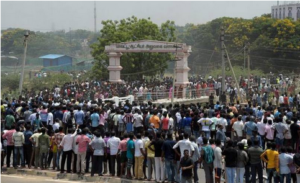
It would be tough for the State government to restore normalcy and instill confidence in the minds of the people. A two-member team consisting of Additional Chief Secretary (Transport) P.W.C. Davidar and Principal Secretary (Agriculture) Gagandeep Singh Bedi camped in Thoothukudi to assist the administration to restore peace. This has to a great extent succeeded in normalising the volatile situation.
The two officers enjoy the trust of the people, unlike AIADMK Minister Kadambur C. Raju, who got a hostile reception when he visited the injured in hospital. When this correspondent met Bedi at the collectorate, he said all necessary steps had been taken to ensure a quick return of normalcy and to restore the confidence of the people. Traders were asked to cooperate and steps were taken to operate buses. Besides, the police were withdrawn in phases.
Meanwhile, actor and aspiring politician Rajnikanth who visited the hospital to console the injured got a taste of people’s anger when a young man who was undergoing treatment asked him, “Who are you?” An embarrassed Rajnikanth left the hospital and told the media that anti-social elements had infiltrated the masses in the agitation. He said if protests and agitations continued in this manner, Tamil Nadu would soon become a graveyard. This also drew sharp criticism from several quarters.
The media were not allowed inside the hospital when Deputy Chief Minister O. Panneerselvam came to console the injured. The DGP, T.K. Rajendiran, visited the town on May 27. Tamil Nadu Governor Banwarilal Purohit, too, paid a visit to the injured. While the Tamil Nadu government transferred the investigation into the violence to the Crime Branch-Crime Investigation Department (CB-CID), the National Human Rights Commission took up a suo motu case on the incident. The State government has also instituted a commission of inquiry, headed by Justice Aruna Jagadeesan, a retired judge of the Madras High Court, to look into the details of the firing.
The people of Thoothukudi have paid heavily for fighting against a plant that has been surviving with the active support of the State government. The long-drawn-out struggle has created a public awareness that the effects of human intervention on the environment can be damaging. People are today worried about the degradation of the fragile marine ecosystem. And for the first time here, the need to regulate industries in order to protect the environment is widely accepted, but at a heavy cost.
Sense of betrayal
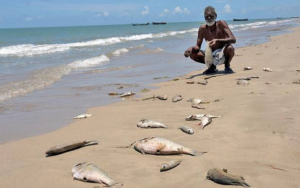
The marginalised fishing community of Thoothukudi is in conflict with land today. As the sea and beaches are inextricably linked to their lives, any move detrimental to the fragile marine ecology on which they have been sustaining for generations also disturbs their lives.
When industrialisation began in earnest in the late 1970s, and later with the neoliberal policies of the 1990s across the country, the 1,076-kilometre coastline of Tamil Nadu, of which Thoothukudi accounts for 121 km, was not spared. Tamil Nadu’s fishermen live in 573 fishing hamlets in 13 coastal districts from Chennai down to Kanyakumari.
Heavy industries and development activities on the shores began pushing the indigenous people away from the beaches, leading to frequent public disorder. The coastline became a dumping yard for poisonous waste that has transformed the landscape for the worse, besides polluting the air and groundwater. Even beach sands are scooped out and looted for minerals, making the community virtual “environment refugees” in their own habitats.
“The tragedy of Thoothukudi lies in its polluting industries. They dumped all hazardous units on us. Now it is a nightmare,” said a fisherman’s representative who is also a stevedore.
The ships that bring in raw materials for a few industries fetch a lot of money, but he regrets the effects of pollution that have destroyed the pristine beaches of Thoothukudi, which lies in a bay in the Gulf of Mannar. Once rich in marine life, Thoothukudi is now left with no natural pearl oysters or exotic varieties of fish. Apprehensive about its fragile marine ecosystem, the Government of India declared it a National Marine Park in 1986 and prohibited any detrimental activity within a 25-km radius.
“It is a major breeding centre as the sea here remains calm all through the year,” said Mathias, a fisherman. Thoothukudi has a fisherfolk population of nearly 80,000. It handled an annual landing of 38,000 tonnes in 2010-11, a marginal increase from 33,000 tonnes recorded in 1996. “The sea is increasingly becoming barren. Industrialisation and pollution have done more harm to us and our sea than anything,” Mathias said.
A marine scientist told Frontline that although pollution played a major role in disturbing the marine ecology, it was the messy and half-hearted modernisation of the fishing industry during the Blue Revolution in 1970 that had brought more woes to fishing and fishermen’s lives. The competitive environment forced traditional fishers out and made them mere labourers in the giant fishing vessels manned by multinationals. At a time when the fishermen at Thoothukudi are struggling to come to terms with the falling catches, they are also forced to face the ill-effects of a rise in polluting industrial activity.
A brief report from the Ministry of Medium and Small Scale Enterprises, Government of India (2012-13), points to the presence of many chemical industries, 854 small and medium, besides a few giants in Thoothukudi.
Most of these units are located within a 20-km radius of the Gulf of Mannar. Thus, living has become perilous for the people of Thoothukudi, especially the fishermen. When a sulphur dioxide gas leak, allegedly from the Sterlite Industries’ copper smelter, occurred on the night of May 23-24, 2013, it triggered a panic. The movement against the copper smelter had started building up with spontaneous participation from all sections of society after the leak, although the fishermen have been fighting against it since its inception.
The fishermen first prevented the plant from laying a pipeline to carry its effluents to the sea. They then staged sea blockades twice on ships that brought in raw materials. A few youths were killed in an earlier incident of violence in 1996 that rocked the city. During the firing on May 22 this year, three members of the fishing community were killed. Yet they have decided to continue their agitation against the industry although the State government ordered its permanent closure.
“The state stands for corporate welfare today. It intimidates and coerces people to accept even if the industry or a development activity makes them sacrifice their lands and waterbodies,” said V. Arasu, former head of the Tamil Department of the University of Madras and a social analyst.
“We will fight and we know that we are not invincible. The repression could weaken our resolve only temporarily. We feel betrayed. We urge the state to ensure us clean air and water to live,” said Jesu, a young fisherman.